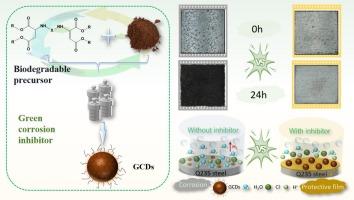Spent coffee grounds-derived N-doped carbon dots as efficient green corrosion inhibitors for Q235 steel in acidic environment
IF 7.3
2区 材料科学
Q1 CHEMISTRY, APPLIED
引用次数: 0
Abstract
Carbon dots (CDs) are gaining considerable attention as green corrosion inhibitors, due to their eco-friendly nature and sustainable production methods. In this study, CDs were synthesized via the hydrothermal method using biomass waste, spent coffee grounds, as a carbon source, with polyaspartic acid as a nitrogen doping source. The chemical composition, fluorescence properties, and morphology of the synthesized spent coffee grounds-derived N-doped carbon dots (GCDs) were deeply characterized. Moreover, Electrochemical analysis and weight loss experiments were conducted to investigate the corrosion inhibition performance on Q235 steel in 1 M HCl. Our findings indicated that at a concentration of 10 mg/L, the corrosion inhibition efficiency reached 93.9 %. Additionally, the GCDs acted as mixed-type corrosion inhibitors, and the adsorption behavior was confirmed to the Langmuir adsorption model, where GCDs formed a stable protective film on the steel surface through chemical coordination with Fe atoms, thereby enhancing corrosion resistance. This work offers valuable insights into the development of environmentally friendly corrosion inhibitors to enrich their related applications.

废咖啡渣衍生的n掺杂碳点作为酸性环境中Q235钢的高效绿色缓蚀剂
碳点(cd)作为绿色缓蚀剂,由于其生态友好性和可持续性的生产方法而备受关注。本研究以废咖啡渣为碳源,聚天冬氨酸为氮掺杂源,采用水热法合成CDs。对合成的废咖啡渣衍生的n掺杂碳点(GCDs)的化学组成、荧光性质和形貌进行了深入表征。此外,通过电化学分析和失重实验研究了Q235钢在1 M HCl中的缓蚀性能。结果表明,在浓度为10 mg/L时,其缓蚀效率可达93.9%。此外,GCDs作为混合型缓蚀剂,其吸附行为符合Langmuir吸附模型,GCDs通过与铁原子的化学配位在钢表面形成稳定的保护膜,从而增强了钢的耐蚀性。这项工作为环境友好型缓蚀剂的开发提供了有价值的见解,以丰富其相关应用。
本文章由计算机程序翻译,如有差异,请以英文原文为准。
求助全文
约1分钟内获得全文
求助全文
来源期刊

Progress in Organic Coatings
工程技术-材料科学:膜
CiteScore
11.40
自引率
15.20%
发文量
577
审稿时长
48 days
期刊介绍:
The aim of this international journal is to analyse and publicise the progress and current state of knowledge in the field of organic coatings and related materials. The Editors and the Editorial Board members will solicit both review and research papers from academic and industrial scientists who are actively engaged in research and development or, in the case of review papers, have extensive experience in the subject to be reviewed. Unsolicited manuscripts will be accepted if they meet the journal''s requirements. The journal publishes papers dealing with such subjects as:
• Chemical, physical and technological properties of organic coatings and related materials
• Problems and methods of preparation, manufacture and application of these materials
• Performance, testing and analysis.
 求助内容:
求助内容: 应助结果提醒方式:
应助结果提醒方式:


